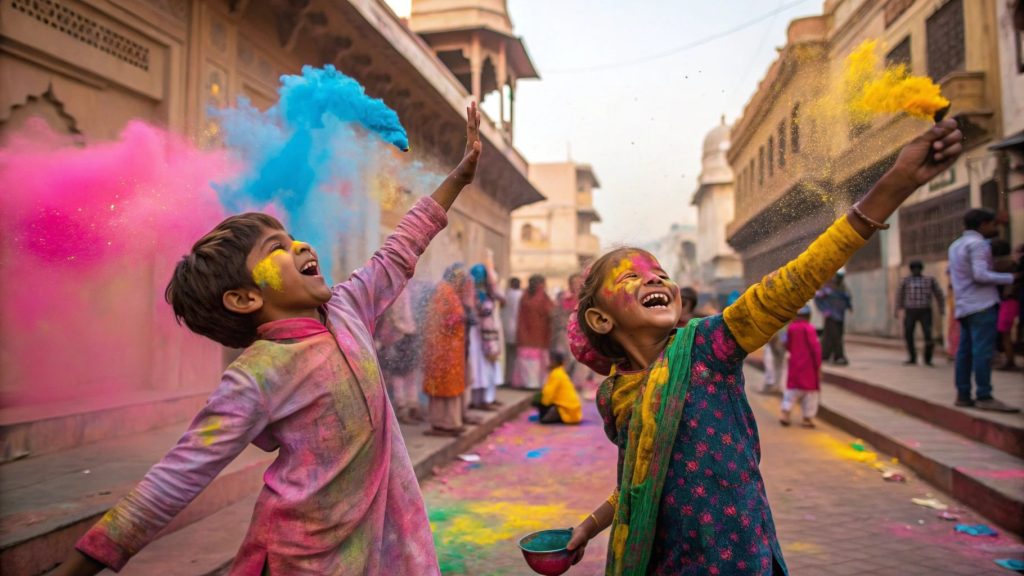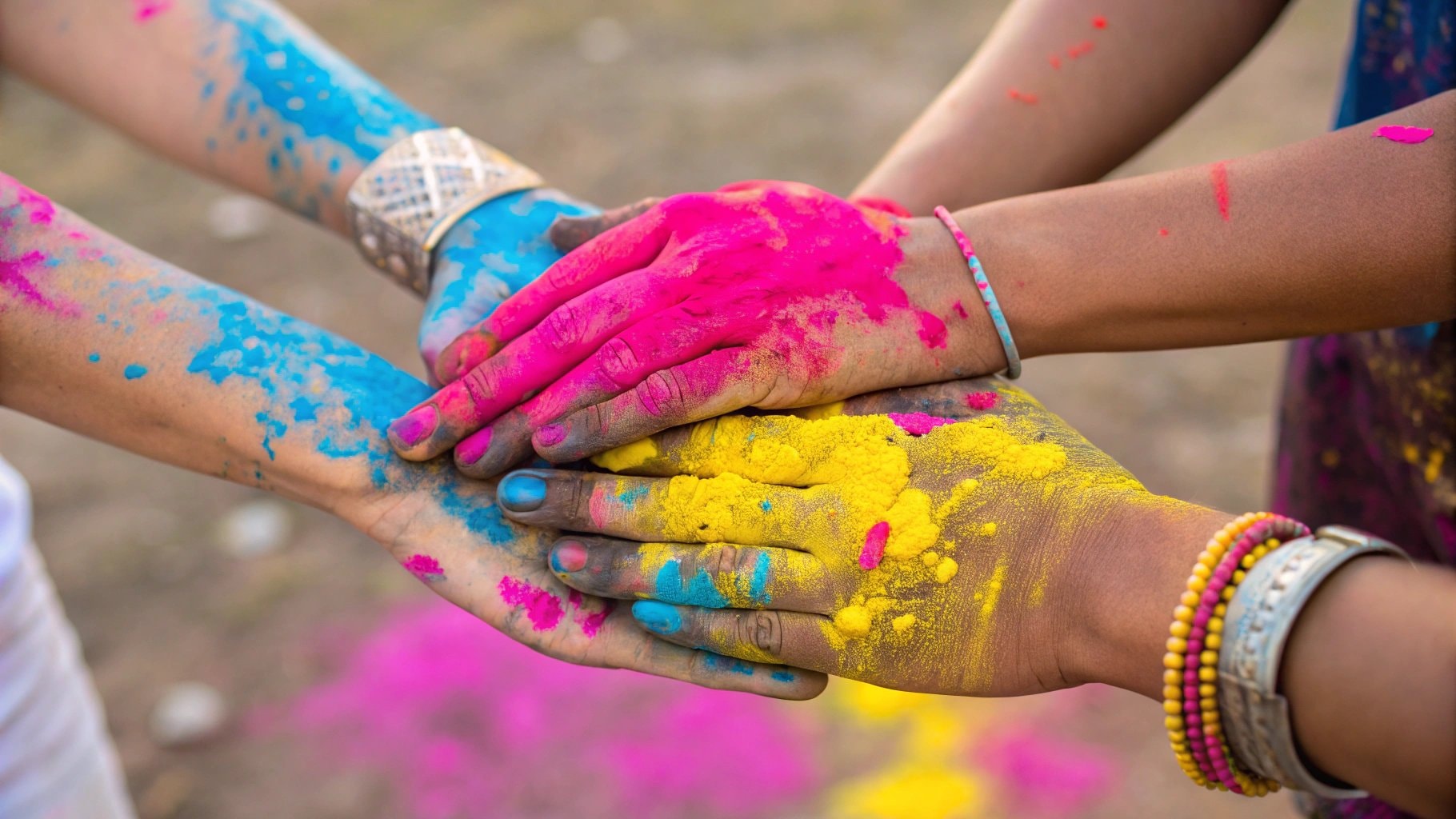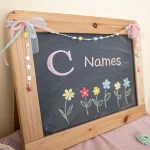Holi 2025 Explained: Date, Meaning & How to Celebrate
Olivia Marie Rose | February 19, 2025

Holi is more than just a festival in India; it is the festival of colours, a riot of music, and sheer joy that brings people together. It marks the end of winter and the beginning of spring, symbolizing renewal, love, and the victory of good over evil. Whether you’ve been celebrating Holi for years or are experiencing it for the first time, the festival offers an unforgettable blend of tradition, spiritual meaning, and revelry.
In 2025, Holi falls on March 14, while Holika Dahan will be observed on March 13. This two-day celebration begins with the ceremonial bonfire of Holika Dahan, representing the triumph of righteousness. The next day, people come together to smear colors on each other, dance to festive beats, and indulge in delicious sweets.
Understanding the deeper meaning of Holi, its legends, and unique traditions can enrich your experience, whether you celebrate in India or anywhere across the world.
Holi 2025 Date & Muhurat Timing
When is Holi in 2025?
Holi is celebrated on the full moon day of Phalguna, the Hindu lunar month, which in 2025 falls on March 14. The festivities begin a day earlier with Holika Dahan on March 13. The specific Holi dates are crucial as they include the timings for significant rituals like Holika Dahan and the celebration schedule in different regions of India, emphasizing the importance of choosing the right muhurta and celebrating in accordance with traditional customs.
Holika Dahan Muhurat Timing
The exact timing for Holika Dahan is determined based on Hindu Panchang calculations. Typically, the bonfire is lit during the evening hours when the Purnima Tithi (full moon period) is in effect. In 2025, the Muhurat for Holika Dahan is from 11:26 PM to 12:30 AM.
The significance of the muhurat is deeply rooted in Vedic traditions, as performing the Holika Dahan ceremony at the right time ensures positive energy, prosperity, and protection against evil. Many families gather to perform prayers, seeking blessings for happiness and well-being.
The Mythological Significance of Holi
Holi has its roots in several Hindu legends that highlight its deeper spiritual significance.
Prahlad & Holika – The Triumph of Good Over Evil
According to mythology, King Hiranyakashipu, a demon king, sought immortality and demanded that everyone worship him instead of the gods. However, his own son, Prahlad, was a devoted follower of Lord Vishnu. Enraged by his son’s defiance, the king sought to kill him with the help of his sister Holika, who had a boon making her immune to fire. She tricked Prahlad into sitting with her in a burning pyre, but divine intervention led to Holika perishing while Prahlad remained unharmed. This event is commemorated with the Holika Dahan bonfire.
This story teaches the importance of unwavering faith and the ultimate victory of righteousness. It reinforces the belief that evil may seem powerful, but truth and goodness always prevail.
Krishna & Radha – A Festival of Love
Another beautiful legend traces the festival back to Lord Krishna, who, as a child, was worried about his dark complexion compared to Radha’s fair skin. His mother, Yashoda, playfully suggested he color Radha’s face to remove the difference. This playful tradition evolved into the color-throwing we associate with Holi today, especially in Vrindavan and Barsana.
This aspect of Holi represents love and unity. The throwing of colors signifies breaking barriers of caste, gender, and social status, as everyone is painted in the same vibrant hues of happiness.
Kaamdev & Shiva – The Fire of Desire
Holi also has links to the story of Kaamdev, the god of love. According to mythology, Lord Shiva went into deep meditation after losing his wife, Sati. To bring him back, Kaamdev shot his arrow of love, but in return, Shiva burned him to ashes. Later, Kaamdev’s wife pleaded for his revival, and he was resurrected, albeit in a spiritual form. This tale associates Holi with love and renewal, making it a time for new beginnings in relationships.
Holi, therefore, is not just about fun but also about devotion, sacrifice, and divine grace.
How Holi is Celebrated in India
Day 1: Holika Dahan (Chhoti Holi)
On this evening, people gather around large bonfires to perform rituals, sing folk songs, and burn symbolic negativity in the flames. It’s a night of spiritual cleansing and renewal, reminding us to let go of resentment and embrace positivity.
Day 2: Rangwali Holi (Festival of Colors)
The second day, commonly known as Rangwali Holi, is when people step out to play with vibrant colors, water balloons, and music. People joyfully throw and apply holi powder on each other, creating a festive atmosphere. Streets and parks turn into colorful playgrounds where friends, families, and even strangers apply powdered colors (Gulaal) on each other, dance, and enjoy traditional treats.
Holi is celebrated with different traditions across India, making it a diverse and colorful festival. Each region adds its own cultural touch, making the celebrations unique and special. Here’s how different parts of India celebrate Holi:
Regional Variations of Holi in India
1. Barsana & Nandgaon – Lathmar Holi
In Barsana and Nandgaon, Holi is not just about colors; it’s about tradition and playful teasing. Known as Lathmar Holi, women chase men with sticks (lathis) while men try to shield themselves. This tradition symbolizes the playful love between Radha and Krishna. The atmosphere is full of laughter, music, and joy, making it one of the most exciting Holi celebrations in India. Holi rituals in the Braj region, including Lathmar Holi, highlight the cultural and religious practices that mark the two-day celebration, featuring traditional activities like Holika Dahan and the vibrant play with colors on Rangwali Holi.
2. Vrindavan & Mathura – The Heart of Holi
Mathura and Vrindavan celebrate Holi Utsav for an entire week, paying tribute to Lord Krishna’s childhood days. The most famous event is Phoolon Wali Holi, where instead of colored powder, flowers are showered on devotees inside the Banke Bihari Temple. The Widow’s Holi in Vrindavan is another touching celebration, allowing widows, who were once excluded from festivities, to join in and play with colors. Holi songs are also an integral part of the celebrations, honoring deities like Lord Krishna and Goddess Radha, and fostering joy and community spirit during the festival.
3. Punjab – Hola Mohalla
In Punjab, Holi takes on a warrior spirit with Hola Mohalla, a tradition started by Guru Gobind Singh. This version of Holi is filled with martial arts demonstrations, horse riding, and mock battles. Instead of just playing with colors, Sikh warriors (Nihangs) showcase their skills, making it a high-energy and thrilling celebration.
4. West Bengal – Dol Jatra
In West Bengal, Holi is celebrated as Dol Jatra or Dol Purnima. Devotees carry beautifully decorated idols of Radha and Krishna on palanquins and dance to devotional songs. People wear traditional white and yellow attire, symbolizing spirituality and joy. The celebrations here are more graceful and musical, with singing, dancing, and throwing of abir (colored powder) in the air.
5. Uttar Pradesh – Hurdang Holi in Kanpur
Kanpur hosts one of the biggest Holi parties, known as Hurdang Holi. The city comes alive with massive color fights, water balloons, and loud music. It is one of the most energetic and enthusiastic Holi celebrations in India. People come together to play Holi with colors and water, embracing the vibrant traditions of Rangwali Holi.
6. Bihar – Holi with Bhang
In Bihar, Holi is played with vibrant colors and traditional bhang (a drink made from cannabis leaves). People sing folk songs, dance to dhol beats, and enjoy delicious sweets like Malpua and Thekua. The energy here is unmatched, and the festival is all about fun and letting loose.
7. Maharashtra – Rangpanchami & Matki Phod
In Maharashtra, Rangpanchami is the main day of color play. Inspired by Krishna’s love for butter, young boys form human pyramids to break a pot (matki) filled with buttermilk, while women throw water and colors at them. This represents Krishna’s mischievous side, and the event is full of excitement.
8. Rajasthan – Royal Holi in Udaipur & Jaipur
Holi in Rajasthan is a mix of royal elegance and vibrant colors. In Jaipur and Udaipur, the royal families host grand celebrations with elephants, folk performances, and lavish feasts. The Elephant Festival in Jaipur, where elephants are decorated and paraded, is a major attraction.
9. Goa – Shigmo Festival
Goa celebrates Holi as Shigmo, a spring festival filled with folk dances, processions, and drum performances. Unlike the usual Holi celebrations, Shigmo has a strong cultural and traditional feel, with farmers and rural communities taking the lead in festivities.
10.Manipur – Yaoshang Festival
In Manipur, Holi merges with Yaoshang, a six-day festival that includes color play, traditional Thabal Chongba (moonlight dance), and cultural performances. The celebrations have a spiritual essence, blending dance, music, and devotion.
Each of these regional variations adds to the magic of Holi, making it a festival that unites people in joy, devotion, and celebration. No matter where you are in India, Holi offers an unforgettable experience filled with colors, traditions, and happiness.
Best Places to Experience Holi 2025

Holi is a grand celebration across India, and some destinations offer an unforgettable experience with their unique traditions, scale of festivities, and cultural significance. If you’re looking to witness the most vibrant Holi celebrations in 2025, consider these must-visit places:
Mathura & Vrindavan – The Heart of Holi
As the birthplace of Lord Krishna, Mathura and Vrindavan host some of the most spirited Holi celebrations. The festival here lasts for weeks, with different events leading up to the main day. The Banke Bihari Temple in Vrindavan hosts Phoolon Wali Holi, where flowers are showered instead of colors. Devotees flock to the Dwarkadhish Temple in Mathura for special rituals and celebrations. If you want to immerse yourself in Krishna’s playful Holi traditions, this is the place to be. Holi marks the arrival of spring with vibrant colors, symbolizing the joyous transition from winter to a lively, colorful season.
Barsana & Nandgaon – Lathmar Holi
Holi here is unlike any other. Barsana and Nandgaon, the villages associated with Radha and Krishna, host Lathmar Holi, where women playfully hit men with sticks as part of a centuries-old tradition. Men try to protect themselves with shields while colors fill the air, and the celebration is accompanied by devotional songs and enthusiastic dancing. It’s an energetic and fun-filled experience with deep cultural roots.
Jaipur & Udaipur – Royal Holi Celebrations
For a majestic and royal Holi, Jaipur and Udaipur offer a unique blend of traditional and regal festivities. In Jaipur, the City Palace hosts an exclusive Holi event with traditional Rajasthani folk performances, elephant processions, and grand feasts. Udaipur’s Jagmandir Palace and lakeside venues witness cultural performances and Holika Dahan bonfires, making it one of the most picturesque Holi celebrations in India.
Delhi – Holi Music Festivals & Parties
Delhi transforms into a colorful carnival during Holi. The city hosts massive Holi parties and music festivals, featuring live DJs, dance performances, rain showers, and organic colors. Events like Holi Moo Festival and Rang Leela attract thousands of people looking for an energetic and modern Holi experience. Whether you prefer a spiritual celebration at temples or a high-energy festival, Delhi has something for everyone.
Pushkar – Backpackers’ Paradise for Holi
Pushkar, a small town in Rajasthan, is a favorite among international travelers looking to experience Holi. The main square turns into a giant party, where locals and tourists dance, throw colors, and enjoy local folk music. The town’s beautiful lakes and ghats add to the charm, making it a perfect blend of spirituality and celebration.
Shantiniketan – A Cultural Holi Experience
In West Bengal, Holi is celebrated as Basanta Utsav (Spring Festival) at Shantiniketan, the university town established by Rabindranath Tagore. Unlike other parts of India, Holi here is marked by traditional Bengali songs, dance performances, poetry recitations, and cultural programs. It’s a serene and artistic take on the festival, perfect for those who want a graceful and cultural Holi experience.
Traditional Holi Foods & Sweets
No Holi celebration is complete without indulging in traditional festive treats. Across India, different regions prepare special dishes that add a flavorful touch to the celebrations.
Gujiya – The Iconic Holi Sweet
Gujiya is a crispy, deep-fried pastry filled with khoya (reduced milk), nuts, and coconut. It’s a must-have Holi delicacy in North India, often served with a side of warm thandai.
Thandai – The Festive Drink
A refreshing, milk-based drink, thandai is made with almonds, saffron, fennel, and cardamom. Many people also add bhang (cannabis-infused paste) to make it more festive. Thandai is enjoyed across North India, especially in Varanasi and Mathura.
Malpua – A Sweet Pancake Treat
Malpua, a deep-fried and sugar-soaked pancake, is another favorite during Holi. Often served with rabri (thickened sweet milk), this dessert is especially popular in Rajasthan, Bihar, and Odisha.
Puran Poli – A Maharashtrian Delicacy
Maharashtra’s Holi celebrations are incomplete without Puran Poli, a stuffed sweet flatbread made with jaggery, lentils, and cardamom. It’s served with ghee and is loved for its soft, rich texture.
Dahi Bhalla – A Spicy-Sweet Holi Snack
A popular North Indian chaat, Dahi Bhalla consists of lentil dumplings soaked in yogurt, and topped with tangy chutneys, pomegranate seeds, and spices. It provides a perfect balance of sweet, spicy, and tangy flavors.
Holi 2025 Safety Tips & Eco-Friendly Celebrations
Holi is all about fun, but ensuring safety and playing responsibly is important. Here’s how you can protect yourself and celebrate sustainably:
Protecting Your Skin & Hair
Apply coconut or mustard oil on your skin and hair before playing to create a protective layer.
Wear sunglasses to shield your eyes from color powder and avoid irritation.
Opt for full-sleeve clothing to minimize direct contact with synthetic colors.
Playing an Eco-Friendly Holi
Use organic and natural colors made from flowers and herbs. These are skin-friendly and biodegradable.
Opt for a dry Holi to reduce water wastage. Instead of water balloons, use flower petals or dry colors.
Encourage community Holi celebrations with herbal colors, reducing the impact on the environment.
General Safety Measures
Avoid synthetic colors containing harmful chemicals like lead and mercury, which can cause skin allergies.
Stay hydrated throughout the day, as playing under the sun can lead to dehydration.
Celebrate in a safe environment and be mindful of people around you. Always respect personal boundaries and ensure consent before applying colors.
Holi is a time to spread joy, forgiveness, and togetherness. Whether you’re celebrating in the streets of Mathura, the palaces of Jaipur, or the cultural hubs of Shantiniketan, make sure to play safe, eat well, and enjoy every moment of this beautiful festival.
Conclusion
Holi 2025 is set to be a vibrant celebration of joy, unity, and renewal. Whether you’re in India or abroad, the festival brings people together, dissolving barriers with colors, laughter, and tradition.
Make this Holi about forgiveness, fresh beginnings, and eco-friendly celebrations. Choose natural colors, conserve water, and celebrate responsibly while keeping the spirit of Holi alive.
Celebrate with an open heart, cherish the traditions, and spread happiness wherever you go!
FAQs About Holi 2025
When is Holi celebrated in 2025?
Holi is celebrated on March 14, 2025, with Holika Dahan occurring the evening before on March 13.
What is the significance of Holika Dahan?
Holika Dahan symbolizes the triumph of good over evil, commemorating the story of Prahlad and Holika from Hindu mythology.
How long does the Holi festival last?
Holi is traditionally a two-day festival, starting with Holika Dahan and followed by Rangwali Holi, the day of colors.
What are some unique regional Holi celebrations in India?
Unique celebrations include Lathmar Holi in Barsana, Phoolon Wali Holi in Vrindavan, and Hola Mohalla in Punjab.
How can I celebrate Holi in an eco-friendly way?
Use natural colors, conserve water by playing dry Holi, and participate in community celebrations with herbal colors.
Recent Posts

Transcendental Meditation: What It Is, Benefits, and How to Get Started
Olivia Marie Rose | February 20, 2025

Angel of Death in History & Religion: A Cultural Perspective
Olivia Marie Rose | February 20, 2025

A Complete Guide to the Tom Cruise Natal Chart & Horoscope
Olivia Marie Rose | February 20, 2025

Neelam Stone Types & Their Benefits – How to Choose the Best One
Olivia Marie Rose | February 20, 2025

The Ultimate Guide to Names That Start With C
Olivia Marie Rose | February 19, 2025
Topics
- Angel Numbers
- Astrology and Birth Charts
- Baby Names
- Best Astrologers
- Business
- Career
- Celebrities and Famous Personalities Astrological Profile
- Children
- Chinese Astrology
- Festivals
- Finance
- Gemstones
- Kundli
- Love
- Marriage Prediction
- Nakshatra
- Numerology
- Pets
- Rudraksha
- Spirit Animals
- Spirituality and Positivity
- Symbolism
- Tarot
- Understanding Hinduism
- Vastu
- Vedic
- Western Astrology Charts
- Yoga and Meditation
- Zodiac Sign Date Calendar
- Zodiac Signs
